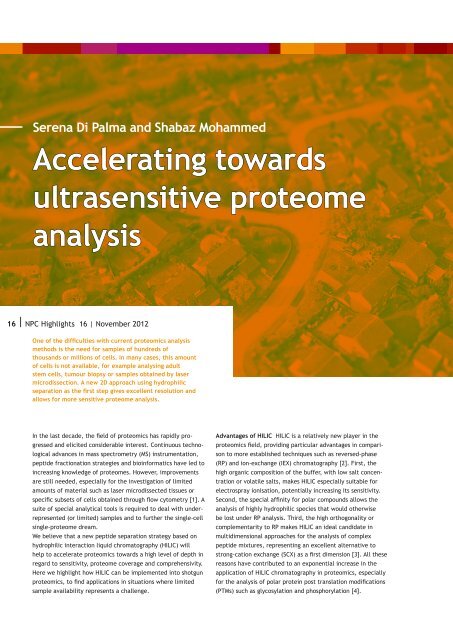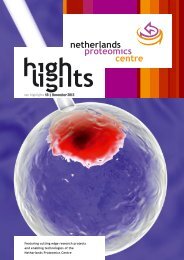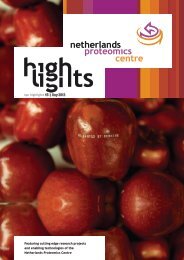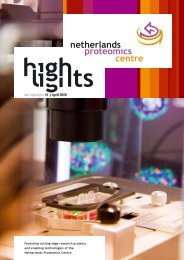NPC Valorisation Voucher - Netherlands Proteomics Centre
NPC Valorisation Voucher - Netherlands Proteomics Centre
NPC Valorisation Voucher - Netherlands Proteomics Centre
Create successful ePaper yourself
Turn your PDF publications into a flip-book with our unique Google optimized e-Paper software.
Serena Di Palma and Shabaz MohammedAccelerating towardsultrasensitive proteomeanalysis16 | <strong>NPC</strong> Highlights 16 | November 2012One of the difficulties with current proteomics analysismethods is the need for samples of hundreds ofthousands or millions of cells. In many cases, this amountof cells is not available, for example analysing adultstem cells, tumour biopsy or samples obtained by lasermicrodissection. A new 2D approach using hydrophilicseparation as the first step gives excellent resolution andallows for more sensitive proteome analysis.In the last decade, the field of proteomics has rapidly progressedand elicited considerable interest. Continuous technologicaladvances in mass spectrometry (MS) instrumentation,peptide fractionation strategies and bioinformatics have led toincreasing knowledge of proteomes. However, improvementsare still needed, especially for the investigation of limitedamounts of material such as laser microdissected tissues orspecific subsets of cells obtained through flow cytometry [1]. Asuite of special analytical tools is required to deal with underrepresented(or limited) samples and to further the single-cellsingle-proteome dream.We believe that a new peptide separation strategy based onhydrophilic interaction liquid chromatography (HILIC) willhelp to accelerate proteomics towards a high level of depth inregard to sensitivity, proteome coverage and comprehensivity.Here we highlight how HILIC can be implemented into shotgunproteomics, to find applications in situations where limitedsample availability represents a challenge.Advantages of HILIC HILIC is a relatively new player in theproteomics field, providing particular advantages in comparisonto more established techniques such as reversed-phase(RP) and ion-exchange (IEX) chromatography [2]. First, thehigh organic composition of the buffer, with low salt concentrationor volatile salts, makes HILIC especially suitable forelectrospray ionisation, potentially increasing its sensitivity.Second, the special affinity for polar compounds allows theanalysis of highly hydrophilic species that would otherwisebe lost under RP analysis. Third, the high orthogonality orcomplementarity to RP makes HILIC an ideal candidate inmultidimensional approaches for the analysis of complexpeptide mixtures, representing an excellent alternative tostrong-cation exchange (SCX) as a first dimension [3]. All thesereasons have contributed to an exponential increase in theapplication of HILIC chromatography in proteomics, especiallyfor the analysis of polar protein post translation modifications(PTMs) such as glycosylation and phosphorylation [4].






